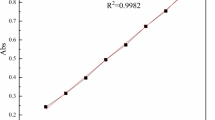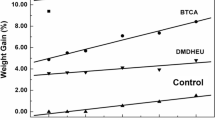Abstract
Cellulosic material is chemically modified to impart crease-resistant properties to textile products. Due to health considerations formaldehyde-free chemicals are preferred. For this purpose, (3-glycidyloxy)propyltrimethoxysilane (GPTMS) in combination with metal alkoxides aluminium isopropoxide (AIP), titanium tetraisopropoxide (TTP), zircon tetrabutoxide (ZTB) were applied to cotton raw material and cotton fabrics which were pre-treated with butane-1,2,3,4-tetracarboxylic acid (BTCA)/sodium hypophosphite. The as-prepared samples were tested for dry crease recovery angle, tensile strength, tear strength, air permeability, contact angle and whiteness index. The application of GPTMS/AIP resulted in excellent crease resistance values, whereas TTP and ZTB provided a moderate improvement of the wrinkle resistance. The application of the hydrophobic methyltriethoxysilane, octyltriethoxysilane and Dynasylan F8815 (fluoroalkylfunctional water-borne oligosiloxane) caused a significant increase in the contact angle. Fourier-transform-infrared spectroscopy proved the formation of an ester-linkage between BTCA and the cellulose.






Similar content being viewed by others
References
Alongi J, Malucelli G (2013a) Heat and moisture transfer in sol–gel treated cotton fabrics. J Therm Anal Calorim 111(1):459–465. doi:10.1007/s10973-012-2462-8
Alongi J, Malucelli G (2013b) Thermal stability, flame retardancy and abrasion resistance of cotton and cotton–linen blends treated by sol–gel silica coatings containing alumina micro- or nano-particles. Polym Degrad Stab 98(8):1428–1438. doi:10.1016/j.polymdegradstab.2013.05.002
Bahners T, Textor T, Opwis K, Schollmeyer E (2008) Recent approaches to highly hydrophobic textile surfaces. J Adhes Sci Technol 22(3–4):285–309
Bajaj P (2002) Finishing of textile materials. J Appl Polym Sci 83(3):631–659. doi:10.1002/app.2262
Bashar MM, Khan M (2013) An overview on surface modification of cotton fiber for apparel use. J Polym Environ 21(1):181–190. doi:10.1007/s10924-012-0476-8
Bradley DC, Mehrotra RC, Rothwell IP, Singh A (2001) Alkoxo and aryloxo derivatives of metals. Academic Press, London
Brinker CJ, Scherer GW (1990) Sol–gel science, the physics and chemistry of sol–gel processing. Academic Press, San Diego
Carboni D, Pinna A, Malfatti L, Innocenzi P (2014) Smart tailoring of the surface chemistry in GPTMS hybrid organic–inorganic films. New J Chem 38(4):1635. doi:10.1039/c3nj01385e
Cassie ABD, Baxter S (1944) Wettability of porous surfaces. Trans Faraday Soc 40:546–551. doi:10.1039/TF9444000546
Chapman RA (2010) Applications of nonwovens in technical textiles, vol 102. Woodhead Publishing Limited. doi:10.1533/9781845699741
Chu L, Daniels MW, Francis LF (1997) Use of (glycidylpropyl)trimethoxysilane as a binder in colloidal silica coatings. Chem Mater 9:2577–2582
Dehabadi VA, Buschmann HJ, Gutmann JS (2013) Durable press finishing of cotton fabrics: an overview. Text Res J 83(18):1974–1995. doi:10.1177/0040517513483857
Frick JG Jr, Harper RJ Jr (1981) Adducts of glyoxal and amides as finishing agent for cotton. Text Res J 51(9):601–606
Froix MF, Nelson R (1975) The interaction of water with cellulose from nuclear magnetic resonance relaxation times. Macromolecules 8(6):726–730. doi:10.1021/ma60048a011
Gabrielli L, Russo L, Poveda A, Jones JR, Nicotra F, Jimenez-Barbero J, Cipolla L (2013) Epoxide opening versus silica condensation during sol–gel hybrid biomaterial synthesis. Chem Eur J 19(24):7856–7864. doi:10.1002/chem.201204326
Harifi T, Montazer M (2012) Past, present and future prospects of cotton cross-linking: new insight into nano particles. Carbohydr Polym 88(4):1125–1140. doi:10.1016/j.carbpol.2012.02.017
Hench LL, West JK (1990) The sol–gel process. Chem Rev 90:33–72
Hewson M (1994) Formaldehyde in textiles. J Soc Dyer Color 110(4):140–142
Hishikawa Y, Togawa E, Kataoka Y, Kondo T (1999) Characterization of amorphous domains in cellulosic materials using a FT-IR deuteration monitoring analysis. Polymer 40(25):7117–7124. doi:10.1016/S0032-3861(99)00120-2
Hishikawa Y, S-i Inoue, Magoshi J, Kondo T (2005) Novel tool for characterization of noncrystalline regions in cellulose: a FT-IR deuteration monitoring and generalized two-dimensional correlation spectroscopy. Biomacromolecules 6(5):2468–2473. doi:10.1021/bm050032k
Hoebbel D, Nacken M, Schmidt H (2000) The effect of nanoscaled metal oxide sols on the structure and properties of glycidoxypropyltrimethoxysilane derived sols and gels. J Sol-Gel Sci Technol 19:305–309
Hoebbel D, Nacken M, Schmidt H (2001) On the influence of metal alkoxides on the epoxide ring-opening and condensation reactions of 3-glycidoxypropyltrimethoxysilane. J Sol-Gel Sci Technol 21:177–187
Huang KS, Hwang MC, Chen JS, Lin SJ, Wang SP (2007) Application of mixed gel solution in the anti-wrinkle finishing of cotton fabrics. J Text Inst 98(2):169–176. doi:10.1533/joti.2005.0300
Jedlinski Z, Dworak A, Bero M (1979) Ring opening in the polymerization of propylene oxide by the initiator systems aluminium isopropoxide or aluminium isopropoxide/zinc chloride (1:1) and the microstructure of the resulting polymers. Die Makromolekulare Chemie 180(4):949–952. doi:10.1002/macp.1979.021800410
Kan CW, Au CH (2014) Effect of biopolishing and UV absorber treatment on the UV protection properties of cotton knitted fabrics. Carbohydr Polym 101:451–456. doi:10.1016/j.carbpol.2013.09.044
Kondo T (1997) The assignment of IR absorption bands due to free hydroxyl groups in cellulose. Cellulose 4(4):281–292. doi:10.1023/A:1018448109214
Kondo T, Sawatari C (1996) A Fourier transform infra-red spectroscopic analysis of the character of hydrogen bonds in amorphous cellulose. Polymer 31(3):293–399
Kwok DY, Neumann AW (1999) Contact angle measurement and contact angle interpretation. Adv Colloid Interface Sci 81(3):167–249. doi:10.1016/s0001-8686(98)00087-6
Lee TH, Kang ES, Bae BS (2003) Catalytic effects of aluminium butoxyethoxide in sol–gel hybrid hard coatings. J Sol-Gel Sci Technol 27:23–29
Mahltig B, Böttcher H (2003) Modified silica sol coatings for water-repellent textiles. J Sol-Gel Sci Technol 27:43–52
Mahltig B, Textor T (2008) Nanosols and textiles. World Scientific Publishing Co. Pte. Ltd., Singapore
Montazer M, Hashemikia S (2012) Textile with immobilised nano titanium dioxide for repeated discoloration of CI Reactive Black 5 under UV-A. Color Technol 128(5):403–409. doi:10.1111/j.1478-4408.2012.00394.x
Nazari A, Montazer M, Moghadam MB (2012) Introducing covalent and ionic cross-linking into cotton through polycarboxylic acids and nano TiO2. J Text Inst 103(9):985–996. doi:10.1080/00405000.2011.646678
Pan C, Shen L, Shang S, **ng Y (2012) Preparation of superhydrophobic and UV blocking cotton fabric via sol–gel method and self-assembly. Appl Surf Sci 259:110–117. doi:10.1016/j.apsusc.2012.07.001
Parker RE, Isaacs NS (1959) Mechanisms of epoxide reactions. Chem Rev 59(4):737–799. doi:10.1021/cr50028a006
Qi KH, Daoud WA, **n JH, Mak CL, Tang WZ, Cheung WP (2006) Self-cleaning cotton. J Mater Chem 16(47):4567–4574. doi:10.1039/b610861j
Schindler WD, Hauser PJ (2004) Chemical finishing of textiles. Woodhead Publishing Limited, Cambridge
Schramm C, Rinderer B (2011) Dyeing and DP treatment of sol–gel pre-treated cotton fabrics. Fibers Polym 12(2):226–232. doi:10.1007/s12221-011-0226-x
Schramm C, Binder W, Tessadri R (2004) Durable press finishing of cotton fabric with 1,2,3,4-butanetetracarboxylic acid and TEOS/GPTMS. J Sol-Gel Sci Technol 29:155–165
Schramm C, Rinderer B, Tessadri R (2014) Non-formaldehyde, crease resistant agent for cotton fabrics based on an organic–inorganic hybrid material. Carbohydr Polym 105:81–89. doi:10.1016/j.carbpol.2014.01.063
Shishoo R (2005) Textiles in sport. CRC-Press, New York
Stalder AF, Kulik G, Sage D, Barbieri L, Hoffmann P (2006) A snake-based approach to accurate determination of both contact points and contact angles. Colloids Surf A 286(1–3):92–103. doi:10.1016/j.colsurfa.2006.03.008
Tao X (2001) Smart fibres, fabrics and clothing. Woodhead Publishing Limited, Cambridge
Wei Q (2009) Surface modification of textiles. Woodhead Publishing Limited, Cambridge.
Welch CM (1988) Tetracarboxylic acids as formaldehyde-free durable press finishing agents. Part I: catalyst, additive and durability studies. Text Res J 58(8):480–486
Welch CM (1990) Durable press finishing without formaldehyde. Text Chem Color 22(5):13–16
Welch CM (1992) Formaldehyde-free durable press finishing. Rev Prog Color 22:32–41
Welch CM (1994) Formaldehyde-free DP finishing with polycarboxylic acids. Am Dyest Rep 83(9):19–36
Wenzel RN (1936) Resistance of solid surfaces to wetting by water. Ind Eng Chem 28(8):988–994. doi:10.1021/ie50320a024
Williams DBG, Lawton M (2005) Aluminium triflate: a remarkable Lewis acid catalyst for the ring opening of epoxides by alcohols. Org Biomol Chem 3(18):3269–3272. doi:10.1039/B508924G
Wright JD, Sommerdijk NAJM (2001) Sol–gel materials chemistry and applications. Gordon and Breach Science Publisher, The Netherlands
Yamamoto K (1982) Crease-resistant treatment of cotton fabrics with non-formaldehyde crosslinking agents. Text Res J 52(6):357–362
Acknowledgments
The authors would like to thank the Testing Institute of the HTL Dornbirn (Austria) for making available textile-physical devices.
Author information
Authors and Affiliations
Corresponding author
Rights and permissions
About this article
Cite this article
Schramm, C., Rinderer, B. Non-formaldehyde, crease-resistant modification of cellulosic material by means of an organotrialkoxysilane and metal alkoxides. Cellulose 22, 2811–2824 (2015). https://doi.org/10.1007/s10570-015-0664-5
Received:
Accepted:
Published:
Issue Date:
DOI: https://doi.org/10.1007/s10570-015-0664-5




